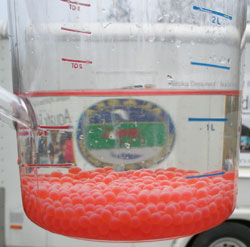Salmon in the Classroom
Overview
 Every September and October, thousands of Alaskan students visit local rivers and creeks to witness the birth of a new generation of salmon. These students are participants in the ADF&G Salmon in the Classroom Program. This innovative, science-based program allows schools to raise salmon from the egg to the fry stage in classroom incubators. Through participation in the project, students learn about the life cycle and biology of Pacific salmon species, their habitat requirements, responsible angling techniques for catching them, and ways to protect Alaska's valuable wild salmon stocks for future generations.
Every September and October, thousands of Alaskan students visit local rivers and creeks to witness the birth of a new generation of salmon. These students are participants in the ADF&G Salmon in the Classroom Program. This innovative, science-based program allows schools to raise salmon from the egg to the fry stage in classroom incubators. Through participation in the project, students learn about the life cycle and biology of Pacific salmon species, their habitat requirements, responsible angling techniques for catching them, and ways to protect Alaska's valuable wild salmon stocks for future generations.
Requirements
To participate, schools must be a recognized public or private educational institution. Generally, one classroom of students conducts the project by housing and maintaining the incubation tank, recording the required data, and by caring for the developing salmon, with one teacher as the primary point of contact between ADF&G and the school. State permits are required in advance to receive salmon eggs for the classroom, and each teacher is required to submit a completion report with specific data at the end of the school year. ADF&G education specialists will assist teachers with the permitting and reporting requirements.
While teachers at all grade levels are welcome to apply to participate in the program, the curriculum has been developed for elementary students. Modifications to the curriculum would be necessary for primary or high school students.
Currently, ADF&G education specialists based out of the Anchorage and Fairbanks offices coordinate regional versions of the Salmon in the Classroom program which are active in the interior and south central areas of the state. Schools in many rural areas are able to participate in a similar program coordinated by University of Alaska Cooperative Extension Service 4-H Natural Resource and Youth Development Program. ADF&G staff offer referral and technical assistance to rural teachers interested in that program.
Equipment
Schools are required to supply their own equipment to raise salmon in the classroom. In some instances, funding may be available from ADF&G to purchase equipment. The main components of a classroom incubator consist of an aquarium and a chiller unit. The cost of these two main components with all other associated materials is generally about $1000. ADF&G education specialists assist teachers in the purchase and initial set-up of these systems.
Overview and timetable
Once a permit is received, up to 250 coho salmon eggs are collected and fertilized during a class field trip to a local river or creek. The eggs are then taken back to the school and placed in the classroom incubator. The students observe the changes throughout the winter as the eggs progress from a newly fertilized egg to an eyed egg, then alevin, and finally fry. The students also record the daily temperature as this is a requirement of the progress report. Water exchanges must be done once a week after the salmon hatch to remove potential waste products from the tank. In the early spring, when the alevin absorb their yolk sacs and become fry, they must be fed. Each classroom will be given a supply of salmon food at this time. At the end of the school year, the salmon fry must either be destroyed or released into a landlocked lake that has been designated on the permit. Throughout the school year, ADF&G education specialists assist teachers by offering technical assistance, resources, kits, and lesson plans to support the project. A curriculum has been developed, referenced to Alaska State educational content standards, that is given to all participating teachers. Education specialists also coordinate classroom presentations and field trips for interested teachers. Progress reports are due from teachers by June 30th of each school year.
Interested in participating in the program? Contact an ADF&G education specialist.
